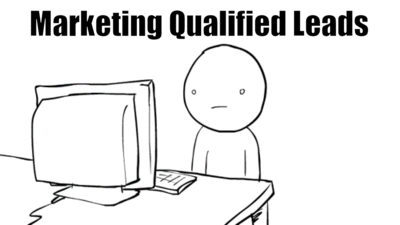marketing
Dear Marketing, That’s Not a Lead. Love, Sales.
A sales rep sits down at her desk first thing in the morning. She opens up her inbox and sees a notification: a new opportunity has been added to her sales pipeline! Heck yeah!
Wait… This company is tiny, the contact isn’t in a relevant department and their budget is laughable. Hold the phone (or to be more literal: don’t hold the phone, because this lead is not worth a sales call).
Thanks a lot, marketing.

Let’s lay down some truths:
- Marketers don’t always do the best job of qualifying leads for sales.
- Unqualified leads make sales reps sad (and waste time).
- Sales and marketing need to have a clear, mutual understanding of what a qualified lead looks like.
Truth #3 is the key to fixing truths #1 and #2, so let’s cover the basics on how to get that strong definition of a qualified lead. Here’s the five step process:
1) Take a look at your existing customers
You need to identify the common traits among them. What’s the average company size? Industry? Department? Geographic location? Maybe the majority of your past deals all used similar software or shared an affinity for Burger King. The specifics don’t matter, because they’ll be different for every company. What does matter is finding out what’s important for you.
2) Take a look at your failed deals
Slightly more depressing, but this will give you a list of warning signs that a lead will not close. Maybe it’s the title of the initial lead or their projected timeline for the purchase. These factors are particularly important because marketing’s involvement with leads typically weakens the further along the opportunities are in the sales process.
3) Build out your definition
Don’t just hand your marketing team a bulleted list of what you’re looking for. You’re better than that. Use a lead definition template to build out your idea of a qualified lead into a handy guide. Include a basic definition of what you’re looking for in an ideal sales lead, examples of what you’re definitely NOT looking for and an outline of a structured process for the lead handoff.
4) Enhance with buyer personas
You know what’s better than one basic lead definition? Short guides of all your ideal buyer personas. Outline the characteristics, goals, sales plays, etc. for each of your most common buyers. Useful for both sales and marketing, these guides help add structure to your buyer strategies.
5) Discuss
Once you have a definition written out, it’s time to get buy-in. Have sales and marketing sit down, go over the lead definition and revise as needed until both parties are happy. I’m not talking about a “Hey Steve, you okay with this definition?” “Uhhh, yeah sure, looks great.” type of conversation. Discuss practical examples and possible fringe cases so that you can be sure sales and marketing both interpret the definition the same way.
6) Profit
Bonus step! Once marketers have a clearer understanding of the type of leads the sales department wants, they can adjust their messaging and marketing efforts accordingly. Ideally, this will result in more of the right kind of leads making their way into pipeline and less of the crummy, disappointing leads.













